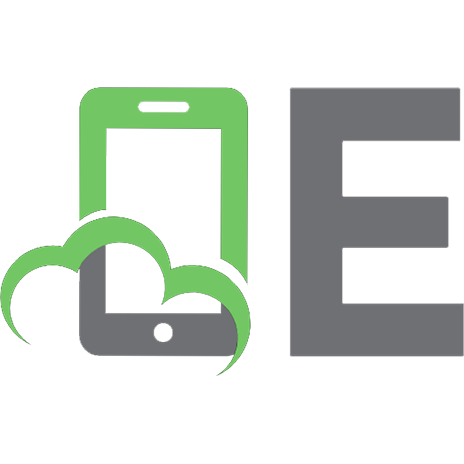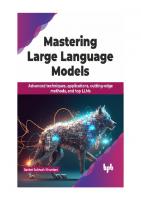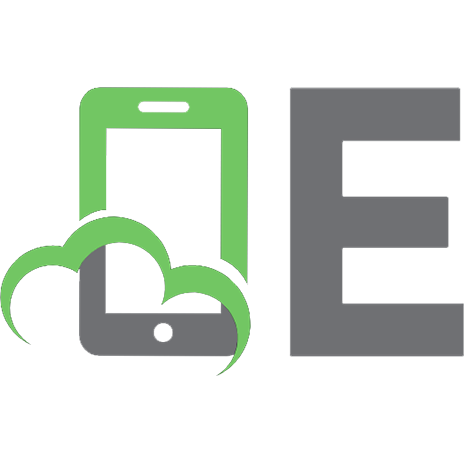LLM, Transformer, RAG AI: Mastering Large Language Models, Transformer Models, and Retrieval-Augmented Generation (RAG) Technology
Explore the world of language models with "LLM, Transformer, RAG AI: Mastering Large Language Models, Transformer M
159 101 25MB
English Pages 382 Year 2024
Table of contents :
Preface
Introduction to Language Model Development
Basics of Natural Language Processing
Choosing the Right Framework
Collecting and Preprocessing Data
Model Architecture Design
Training and Fine-Tuning
Evaluation Metrics and Validation
Deploying Your Language Model
Fine-Tuning for Specific Use Cases
Handling Ethical and Bias Considerations
Optimizing Performance and Efficiency
Popular Large Language Models
GPT-3 (Generative Pre-trained Transformer 3)
BERT (Bidirectional Encoder Representations from Transformers)
T5 (Text-to-Text Transfer Transformer)
XLNet
RoBERTa (Robustly optimized BERT approach)
Llama 2
Google's Gemini
Integrating Language Model with Applications
Scaling and Distributed Training
Continuous Improvement and Maintenance
Interpretable AI and Explainability
Challenges and Future Trends
Case Studies and Project Examples
Community and Collaboration
Introduction to Transformer Models
Understanding the Transformer Architecture
Self-Attention Mechanism
Positional Encoding
Multi-Head Attention
Encoder-Decoder Architecture
Creating a Transformer Model from Scratch
Step 1: Self-Attention Mechanism
Step 2: Multi-Head Attention
Step 3: Positional Encoding
Step 4: Feedforward Neural Network
Step 5: Layer Normalization and Residual Connections
Step 6: Encoder-Decoder Architecture
Step 7: Training and Optimization
Encoder-Only Transformer Models
Understanding Encoder Architecture
Applications of Encoder-Only Models
Training Strategies for Encoder-Only Models
Benefits and Limitations
Decoder-Only Transformer Models
Understanding Decoder Architecture
Applications of Decoder-Only Models
Training Strategies for Decoder-Only Models
Benefits and Limitations
Encoder-Decoder Transformer Models
Introduction to Encoder-Decoder Architecture
Applications of Encoder-Decoder Models
Training Strategies for Encoder-Decoder Models
Benefits and Challenges
Transformer Models in Popular Large Language Models
BERT (Bidirectional Encoder Representations from Transformers)
GPT (Generative Pre-trained Transformer)
T5 (Text-To-Text Transfer Transformer)
XLNet
BERT (Bidirectional Encoder Representations from Transformers)
GPT (Generative Pre-trained Transformer)
Transformer Applications
Natural Language Processing (NLP)
Computer Vision
Audio Processing
Training and Fine-Tuning Transformers
Multi-Modal Transformers
Transfer Learning with Transformers
Ethical Considerations in Transformer Models
Implementing Transformers in Industry
The Transformer Landscape Beyond NLP
Collaborative Development and Open Source Initiatives
Challenges and Future Trends
Introduction to RAG
Understanding Retrieval Models
Generative Language Models
RAG Architecture
Applications of RAG
Fine-Tuning and Customization
Challenges and Considerations
Future Trends in RAG
RAG Best Practices
Popular Applications of RAG AI
Content Creation
Question Answering Systems
Chatbots and Virtual Assistants
Knowledge Base Expansion
Medical Diagnosis Support
Creating RAG AI from Scratch
Data Collection and Preprocessing
Building the Retrieval System
Implementing the Generation Component
Integrating Retrieval and Generation
Training and Fine-Tuning
RAG AI Project Examples
Medical Diagnosis Assistant
Legal Document Summarizer
Code Assistance Tool
Educational Q&A System
Cloud Support for Retrieval-Augmented Generation (RAG) AI
Amazon Web Services (AWS)
Microsoft Azure
Google Cloud Platform (GCP)
IBM Cloud
Oracle Cloud Infrastructure (OCI)
Multimodal RAG
Cross-Language RAG
Dynamic Contextualization
RAG in Real-Time Applications
Ethical Considerations in RAG
Glossary
Bibliography
Preface
Introduction to Language Model Development
Basics of Natural Language Processing
Choosing the Right Framework
Collecting and Preprocessing Data
Model Architecture Design
Training and Fine-Tuning
Evaluation Metrics and Validation
Deploying Your Language Model
Fine-Tuning for Specific Use Cases
Handling Ethical and Bias Considerations
Optimizing Performance and Efficiency
Popular Large Language Models
GPT-3 (Generative Pre-trained Transformer 3)
BERT (Bidirectional Encoder Representations from Transformers)
T5 (Text-to-Text Transfer Transformer)
XLNet
RoBERTa (Robustly optimized BERT approach)
Llama 2
Google's Gemini
Integrating Language Model with Applications
Scaling and Distributed Training
Continuous Improvement and Maintenance
Interpretable AI and Explainability
Challenges and Future Trends
Case Studies and Project Examples
Community and Collaboration
Introduction to Transformer Models
Understanding the Transformer Architecture
Self-Attention Mechanism
Positional Encoding
Multi-Head Attention
Encoder-Decoder Architecture
Creating a Transformer Model from Scratch
Step 1: Self-Attention Mechanism
Step 2: Multi-Head Attention
Step 3: Positional Encoding
Step 4: Feedforward Neural Network
Step 5: Layer Normalization and Residual Connections
Step 6: Encoder-Decoder Architecture
Step 7: Training and Optimization
Encoder-Only Transformer Models
Understanding Encoder Architecture
Applications of Encoder-Only Models
Training Strategies for Encoder-Only Models
Benefits and Limitations
Decoder-Only Transformer Models
Understanding Decoder Architecture
Applications of Decoder-Only Models
Training Strategies for Decoder-Only Models
Benefits and Limitations
Encoder-Decoder Transformer Models
Introduction to Encoder-Decoder Architecture
Applications of Encoder-Decoder Models
Training Strategies for Encoder-Decoder Models
Benefits and Challenges
Transformer Models in Popular Large Language Models
BERT (Bidirectional Encoder Representations from Transformers)
GPT (Generative Pre-trained Transformer)
T5 (Text-To-Text Transfer Transformer)
XLNet
BERT (Bidirectional Encoder Representations from Transformers)
GPT (Generative Pre-trained Transformer)
Transformer Applications
Natural Language Processing (NLP)
Computer Vision
Audio Processing
Training and Fine-Tuning Transformers
Multi-Modal Transformers
Transfer Learning with Transformers
Ethical Considerations in Transformer Models
Implementing Transformers in Industry
The Transformer Landscape Beyond NLP
Collaborative Development and Open Source Initiatives
Challenges and Future Trends
Introduction to RAG
Understanding Retrieval Models
Generative Language Models
RAG Architecture
Applications of RAG
Fine-Tuning and Customization
Challenges and Considerations
Future Trends in RAG
RAG Best Practices
Popular Applications of RAG AI
Content Creation
Question Answering Systems
Chatbots and Virtual Assistants
Knowledge Base Expansion
Medical Diagnosis Support
Creating RAG AI from Scratch
Data Collection and Preprocessing
Building the Retrieval System
Implementing the Generation Component
Integrating Retrieval and Generation
Training and Fine-Tuning
RAG AI Project Examples
Medical Diagnosis Assistant
Legal Document Summarizer
Code Assistance Tool
Educational Q&A System
Cloud Support for Retrieval-Augmented Generation (RAG) AI
Amazon Web Services (AWS)
Microsoft Azure
Google Cloud Platform (GCP)
IBM Cloud
Oracle Cloud Infrastructure (OCI)
Multimodal RAG
Cross-Language RAG
Dynamic Contextualization
RAG in Real-Time Applications
Ethical Considerations in RAG
Glossary
Bibliography

- Similar Topics
- Computers
- Algorithms and Data Structures: Pattern Recognition






![Gesamtverzeichnis des deutschsprachigen Schrifttums: 113: Rag - Ray [113: Rag - Ray]
9783111687858, 3111687856](https://ebin.pub/img/200x200/gesamtverzeichnis-des-deutschsprachigen-schrifttums-113-rag-ray-113-rag-ray-9783111687858-3111687856.jpg)


